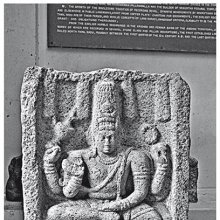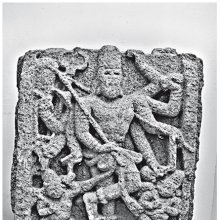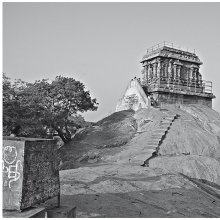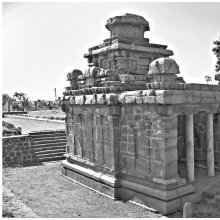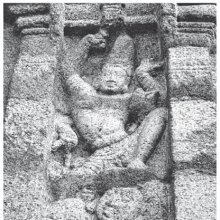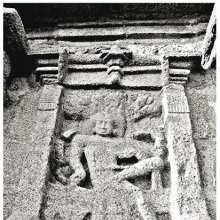Mahabalipura, Mahabalipuram, Mahābalipura, Maha-balipura: 2 definitions
Introduction:
Mahabalipura means something in Hinduism, Sanskrit. If you want to know the exact meaning, history, etymology or English translation of this term then check out the descriptions on this page. Add your comment or reference to a book if you want to contribute to this summary article.
Images (photo gallery)
(+13 more images available)
In Hinduism
Purana and Itihasa (epic history)
Source: archive.org: Shiva Purana - English TranslationMahābalipura (महाबलिपुर) was the ancient capital of Bali or Mahābali.—Bāṇa was the son of Bali also called Mahābali. He ruled at Śoṇitapura while his father’s capital was Mahābalipura. We can construct the ancestry of Bāṇa from Śivapurāṇa: Hiraṇyakaśipu—Prahlāda—Virocana—Bali—Bāṇa.

The Purana (पुराण, purāṇas) refers to Sanskrit literature preserving ancient India’s vast cultural history, including historical legends, religious ceremonies, various arts and sciences. The eighteen mahapuranas total over 400,000 shlokas (metrical couplets) and date to at least several centuries BCE.
Vaishnavism (Vaishava dharma)
Source: Acta Orientalia vol. 74 (2013): Historical sequence of the Vaiṣṇava DivyadeśasMahābalipura is short for Mahābalipurakṣetra (or Māmallapuram, Ardhasetu), which refers to Kaṭalmallai, one of the 108 Vaishnava Divya Desam (divyadeśas or divyasthalas), located in the topographical division of Toṇṭaināṭu (“Northern Tamil Nadu”), according to the 9th century Nālāyirativviyappirapantam (shortly Nālāyiram).—Tradition would record the Vaiṣṇava divyadeśas or divyasthalas are 108. The divyadeśa is a base of the cult of Viṣṇu in Viṣṇuism [Vaiṣṇavism] tradition. The list of 108 [viz., Mahābalipura-kṣetra] seems to have reached maturation by about the early 9th century CE as all the deśas are extolled in the hymns of the twelve Āḻvārs.

Vaishnava (वैष्णव, vaiṣṇava) or vaishnavism (vaiṣṇavism) represents a tradition of Hinduism worshipping Vishnu as the supreme Lord. Similar to the Shaktism and Shaivism traditions, Vaishnavism also developed as an individual movement, famous for its exposition of the dashavatara (‘ten avatars of Vishnu’).
See also (Relevant definitions)
Partial matches: Maha, Puram, Mahabali.
Starts with: Mahabalipurakshetra.
Full-text: Mamallapura, Tiru-katanmallai, Ratha, Talacayanam, Pallava, Mallai, Narasimhavarman, Vaikuntaperumal, Kailasanatha, Mamalla, Rajasimha, Nandivarman, Bhagiratha, Vedi, Kamsa.
Relevant text
Search found 14 books and stories containing Mahabalipura, Maha-balipura, Mahā-balipura, Mahabali-puram, Mahābalipura, Mahabalipuram; (plurals include: Mahabalipuras, balipuras, purams, Mahābalipuras, Mahabalipurams). You can also click to the full overview containing English textual excerpts. Below are direct links for the most relevant articles:
Vastu-shastra (5): Temple Architecture (by D. N. Shukla)
Temples of Mamallapuram or Mahabalipuram < [Chapter 12 - History of Hindu Temples (Prāsādas and Vimānas)]
The Concept of Durga in Mahabalipuram < [October - December 1976]
The Concept of Durga in Mahabalipuram < [July – September 1976]
South Indian Portraits < [January, 1928]
Pallava period (Social and Cultural History) (by S. Krishnamurthy)
Earlier Works < [Chapter 1 - Introduction]
Polygamy < [Chapter 3 - Socio-Religious Life]
Dressing style of sages, ascetics and priests < [Chapter 4 - Material Culture of the People]
Temples of Munnur (Historical Study) (by R. Muthuraman)
Images of Daksinamurti < [Chapter 5]
Images of Subramanya < [Chapter 5]
Introduction: Architecture of the Temple < [Chapter 4]
Temples in and around Madurantakam (by B. Mekala)
Contribution of the Pallavas to the Cherigalpattu District < [Chapter 1 - Historical Backdrop]
Political History (6): The Pallavas < [Chapter 1 - Historical Backdrop]
Later Cholas (in Chengalpattu) < [Chapter 1 - Historical Backdrop]
Lakulisha-Pashupata (Philosophy and Practice) (by Geetika Kaw Kher)
Kapalikas and Natha Siddhas < [Chapter 2 - Spread and Transition]
Iconographical Explanation < [Chapter 5 - The Mythological Bridge]
Related products
